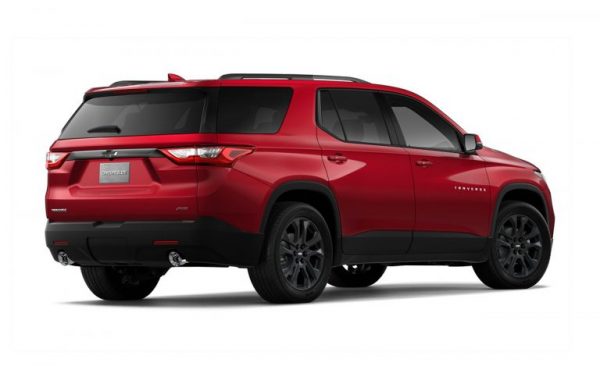With turbocharged performance and aggressive, blacked-out styling cues, the 2018 Traverse RS injects a distinctive dose of fun-to-drive sportiness into the midsize SUV segment.
Based on the redesigned 2018 Traverse, which offers best-in-class maximum cargo room (98.2 cubic feet1), more technologies than the previous model and an enhanced roster of available active safety features, the Traverse RS is part of an expanded six-trim lineup focused on capability, convenience and choice.
“The 2018 Traverse offers a full product lineup positioned to effectively compete across the segment,” said Steve Majoros, Chevrolet marketing director for Cars and Crossovers. “By offering customers more choice with higher-end entries like the RS, which has a more street-inspired look, and top-of-the-line High Country, Chevrolet now offers a comfortable and connected Traverse for every lifestyle.”
The RS’s unique styling elements include a black grille, black window trim, black roof rails and black bowtie emblems, along with 20-inch aluminum wheels featuring a Dark Android finish.
The RS is also the first Traverse model to offer turbocharged performance, delivering a spirited driving experience that is unique within the lineup. A power-dense, direct-injected Ecotec 2.0L turbo engine generates up to 257 horsepower (192 kW) and 295 lb-ft of torque (400 Nm). Ninety percent of the peak torque is available at only 2,100 rpm, for a confident feeling of power on demand at all speeds.
A nine-speed automatic transmission is matched with the engine, contributing to EPA-estimated fuel economy of 20 mpg in city driving and 26 mpg on the highway.
Additional standard content on the Traverse RS includes:
- HID headlamps and LED daytime running lamps
- Upper and lower active aero shutters
- Chevrolet MyLink radio with 8-inch diagonal color touchscreen and navigation
- OnStar® 4G LTE and available built-in Wi-Fi® hotspot (3-month/3GB data trial)2
- Multicolor driver information center display
- Jet Black leather-appointed seating surfaces
- Heated front seats
- Universal Home Remote
- Tri-zone automatic climate control
- Bose premium 10-speaker audio system
- Power liftgate
- Keyless Open with extended-range Remote Keyless Entry
- Remote start
- Lane Change Alert with Side Blind Zone Alert3
- Rear Cross Traffic Alert3
- Rear Park Assist3
- Surround Vision3
- Rear Camera Mirror3
- Rear Seat Reminder4
- Teen Driver3
The Traverse RS is on sale now with an MSRP of $43,095. The price includes the destination charge but excludes tax, title and other dealer fees.
1With second- and third-row seats folded flat. Cargo and load capacity limited by weight and distribution.
2Requires a compatible mobile device, active OnStar service and data plan. 4G LTE service available in select markets. Visit onstar.com for coverage map, details and system limitations. Data plan provided by AT&T.
3Read the vehicle’s owner’s manual for important safety or driver assistance feature limitations and information.
4Does not detect people or items. Always check rear seat before exiting.

